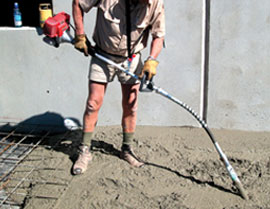
Concrete Compaction – Is it important and how do I know if my slab isn’t adequately compacted?
Compaction is a process which expels entrapped air from freshly placed concrete and packs the aggregate particles of the concrete mix together, increasing the density of the concrete.
How important is it to compact a concrete slab?
Proper compaction of concrete is essential to maintain the structural integrity of the slab, and to assist the concrete slab in achieving its ultimate strength. Benefits of proper concrete compaction include:
- Increased ultimate strength of concrete
- Enhanced bond between concrete and reinforcement
- Increased abrasion resistance and general durability of concrete
- Decreased permeability of concrete, lessening the likelihood of concrete spalling (concrete cancer)
- Minimisation of shrinkage characteristics
- Minimisation of other forms of cracking
When first placed, normal concretes will contain between 5% and 20% of entrapped air. This entrapped air has a huge effect on the finished strength of the concrete. For example, the strength of concrete containing 10% of entrapped air (air voids) may be as little as 50% that of the concrete when fully compacted.
How is concrete compacted?
Generally there are two types of vibrators common on building sites, immersion vibrators and surface vibrators. Sometimes a combination of the two may be utilised to achieve maximum compaction.
|
Immersion vibrators are often referred to as ‘poker’ or ‘needle’ vibrators, which is an instrument inserted vertically into concrete as quickly as possible, and then held stationary until air bubbles cease to rise to the surface. The use of an immersion vibrator is a specialist task and should be carried out in a systematic fashion throughout the slab. Failure to carry out this task systematically (i.e. random patterns), may result in areas of the slab being poorly compacted. Immersion vibrators should never come into contact with the reinforcement within a slab, as this may create further air voids.
|

|
How is poor concrete compaction identified?
Many specifications for the placement of concrete state caution against over-vibration of concrete. However, it is under-vibration that is found to be more common and therefore a greater problem when conducting building inspections in Perth.
Your Perth building inspector will understand the processes involved in the placement of concrete and as such will identify signs that your concrete slab has not been adequately compacted. Cracks identified may be the result of poor concrete compaction, or concrete honeycombing may indicate areas where poor compaction is evident.
When cracks are identified during a Perth building inspection they will be reported as per AS 2870, and your building inspector will monitor the cracking throughout the build process to ensure that movement is not prevalent.
When concrete honeycombing is identified during a Perth building inspection, your building inspector will have to make an educated assumption based upon the location and nature of the honeycombing as to whether it is a structural or cosmetic issue. For example, if the honeycombing exposes any reinforcement then it should be rectified to reduce the likelihood of concrete spalling. In all instances of concrete honeycombing identification during a building inspection, monitoring should be undertaken to ensure it is not a result of poor concrete compaction.
At Cap-It-All building inspections Perth we have over 40 years of industry experience, and are well acquainted with building techniques in Perth. For further information on our services including building and pest inspections please visit our website. Alternatively you can visit our Cap-It-All Building Inspections Perth homepage.
One comment
Write a Reply or Comment
You must be logged in to post a comment.

September 21, 2017
… [Trackback]
[…] Read More here: cap-it-allbuildinginspections.com.au/concrete-compaction-is-it-important-and-how-do-i-know-if-my-slab-isnt-adequately-compacted/ […]